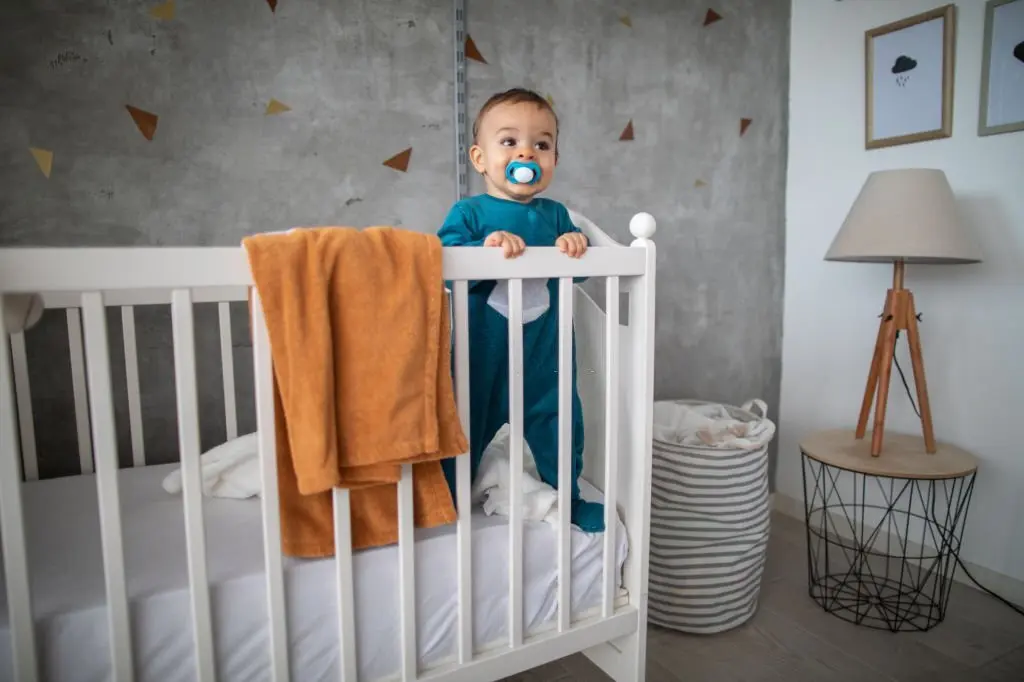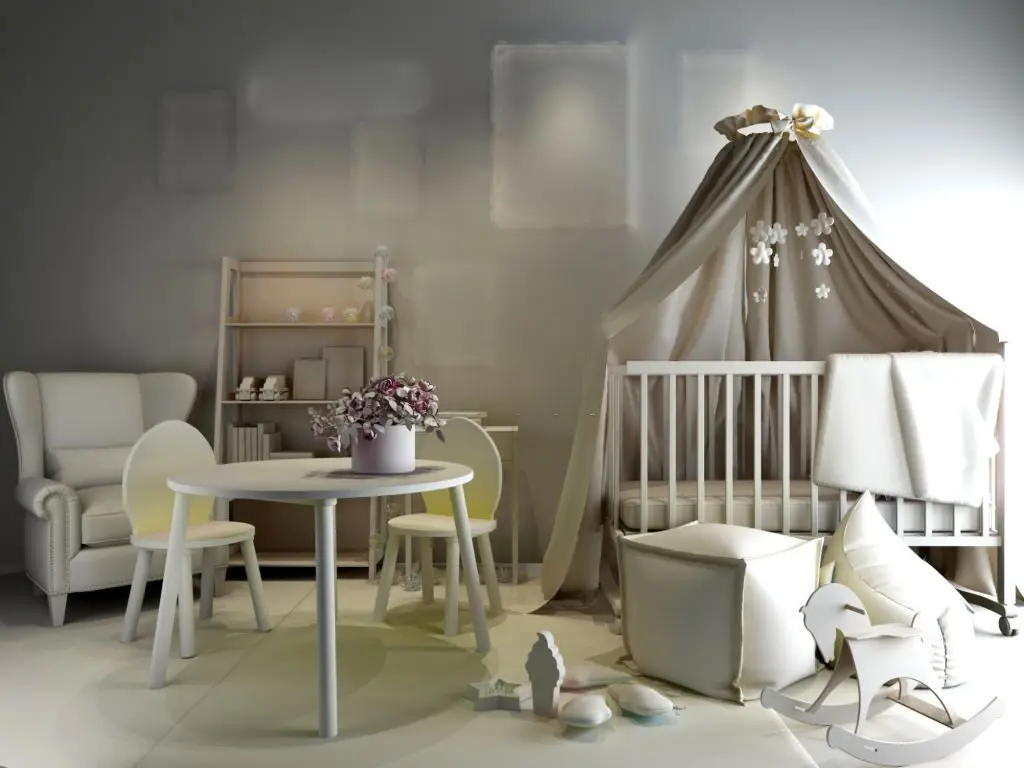How to Prevent Baby from Getting Legs Stuck in Crib

Introduction on How to Prevent Baby from Getting Legs Stuck in Crib
It can be scary as a parent when your baby gets their leg stuck in between the slats of the crib. Their little legs can surprisingly fit into very small spaces. When they try to pull their leg out and realize it’s stuck, it often results in crying and discomfort. Many parents wonder how to keep baby’s legs from getting stuck in crib slats.
As a parent, you want to prevent this from happening as much as possible. Here are some tips on how to prevent baby from getting legs stuck in crib.
Choose the right crib

The first step is to make sure you have the right crib that is designed to prevent leg entrapment accidents. Here are some crib features to look for:
- Slats no more than 2 3/8 inches apart – This is the recommended space between slats by the Consumer Product Safety Commission. Anything wider can allow a baby’s body to fit through.
- Solid ends without cutouts – Some cribs have decorative cutouts on the end panels. A baby’s leg could get stuck in these spaces. Opt for a crib with solid ends.
- Proper mattress fit – Make sure the mattress you use fits snugly in the crib without any gaps on the sides. Gaps can allow little legs to slip through.
Choosing a crib designed specifically to avoid leg entrapment is the #1 way to keep your baby’s legs safe.
Use a sleep sack
Sleep sacks are wearable blankets that zip up your baby’s sleep clothing. They keep your little one warm without the hazard of loose blankets.
Sleep sacks also prevent leg entanglement accidents. With their legs wrapped securely inside, your baby can’t get their legs outside the bars of the crib. Choose a sleep sack instead of loose blankets for all sleep times.
Put baby to sleep properly
How you initially put your baby down to sleep can prevent their legs from getting into dangerous positions:
- Put baby on their back – This is the recommended sleep position to lower the risk of Sudden infant death syndrome (SIDS) anyway. Back sleeping also discourages babies from sticking their legs out between crib bars.
- Avoid footed sleepers – While adorable, footed pajamas make it easier for your baby to poke their feet out between the slats. Choose footless sleepwear.
- Use a thin blanket – Tuck your baby in with a thin blanket just below their chest. Avoid thick or loose blankets that can bunch up and allow the baby to wiggle down toward the foot of the crib.
- Place the crib away from walls – Don’t jam the crib into a corner or up against a wall. Your baby could get their leg caught between the crib bars and wall.
Ensure proper mattress height
If the mattress sits too low in the crib, it creates a gap between the top and the sides. Your baby’s legs can slip through this space and get trapped.
Follow these tips for proper mattress height:
- The mattress should be flush with the top of the crib – When properly installed, the mattress will sit snugly against the sides with no gaps.
- Adjust mattress height as needed – Many cribs have adjustable mattress positions. Raise the mattress height as your baby grows.
- Don’t use mattress pads or toppers – These extra cushy products create gaps that can entrap your baby’s limbs.
Use a crib tent

A crib tent is a mesh canopy that fits over the top of a crib. It zips down the sides and creates a barrier between your baby and the crib slats.
The tight mesh weave is small enough to prevent the legs from poking out. BUT can still allow for visibility and adequate airflow.
Crib tents are portable and fit most standard cribs. Use them as an added layer of protection against leg entrapment.
Monitor your baby
While you can take proactive measures, you also need to monitor your baby closely during the times they are in the crib awake. Watch for potential hazards like:
- Baby scooting down toward the foot of the crib
- Legs poking out between bars
- Legs or feet getting tangled in crib bumpers or blankets
If you see your baby in an unsafe position, immediately adjust them and/or remove the hazardous object. Frequent supervision helps prevent entanglement.
Teach safe sleep habits
As your baby grows older and becomes mobile, teach them safe sleep habits to follow in their crib:
- Stay in the center of the crib
- Keep legs and arms inside bars
- Don’t try to climb or stand up
- Call Mom/dad if need help
Reinforcing these rules as your child develops will help prevent dangerous entanglement situations.
Consider transitioning to a toddler bed
By the time your child is 2-3 years old, it may be time to transition from a crib to a toddler bed. Toddler beds often have shorter side rails with less space between the bars.
This makes it nearly impossible for your toddler to get any limbs stuck. The lower height also allows your child to get in and out of bed safely.
Conclusion: How to prevent baby from getting legs stuck in Crib
A stuck limb may just be part of your baby’s crib adventures. But there are many precautions you can take to avoid leg entrapment accidents. Be mindful of crib design, sleepwear, bedding items, mattress height, and sleep habits.
Frequent supervision also keeps your active baby’s legs safely where they belong – inside the crib! With prevention and attentiveness, you can help your little one get restful sleep without getting stuck. Remember, knowing how to keep baby’s legs from getting stuck in crib is an important part of ensuring your child’s safety and comfort.
Also read:
- The Best Crib: What To Look For When Buying a Crib
- How to Make Baby More Comfortable in Crib
- How to Prevent Baby From Hitting Head on Crib
FAQs about how to prevent baby from getting legs stuck in crib
Is it possible for a baby to break their leg if stuck in the crib?
It’s unlikely for a limb to actually break if trapped between crib bars. But struggling to pull out a stuck leg can result in bruising, swelling, or sprains. Stay close by at nap time to prevent extended entanglement.
What if my crib slats are more than 2 3/8 inches apart?
If your crib is older and does not meet the currently recommended slat spacing, you can still use it safely. Add bumpers around the top rails to fill gaps. Just avoid placing bumpers anywhere your baby could potentially get their legs stuck behind them.
Are mesh liners safe for cribs?
Breathable mesh liners can provide an extra barrier between your baby and the slats. But make sure they fit securely with no loose areas that could trap little arms or legs. Avoid thicker padded liners that can present a suffocation hazard.
My baby rolls all over the crib – how can I keep them safe?
Frequent re-positioning is key. When you hear your active roller stirring at nap time, peek in and adjust their location. Gently move them away from the edges and back to the center of the crib.
What should I do if my baby’s leg does get stuck?
Try to stay calm, even though it’s scary. Gently maneuver their leg to free it, moving it back through the bars. Comfort your little one and watch for signs of injury. Call your pediatrician if they have swelling or bruising.
Why does my baby slam her legs down in her cot?
Babies will often slam their legs down in the crib as a way to self-soothe. The motion and sound provide comfort and stimulation.
Leg slamming usually happens when they are tired and winding down for sleep. It’s completely normal, as long as their legs don’t get caught in the bars. Make sure slat spacing is proper, and use a sleep sack to contain their legs.
What will keep a baby from getting a leg stuck in the baby bed rail?
The best way to prevent a baby from getting their leg stuck in the crib rails is to use a snugly fitting sleep sack. This wearable blanket keeps their legs enclosed and unable to slip between the bars.
Also ensure your crib meets safety standards, with slats no more than 2 3/8 inches apart. Proper mattress height with no gaps along the sides is also important.
What is the difference between crib liners and bumpers?
Crib liners are mesh nets that enclose the whole interior of the crib from top to bottom. They provide a see-through barrier to keep arms and legs in but allow for visibility and airflow. Crib bumpers pad just the upper rails around the top perimeter of the crib.
But bumper use is controversial since they pose a potential suffocation risk. Breathable mesh bumpers are safer than padded bumpers when used correctly. Liners offer more complete protection by covering the entire crib enclosure.
Can baby’s legs get stuck in crib slats?
Yes, it is possible for a baby’s legs to get stuck in crib slats. This is why it’s important to choose a crib with appropriate slat spacing and take preventive measures.
What should I do if my baby’s leg gets caught in crib bars?
If your baby’s leg gets caught in crib bars, stay calm. Gently guide their leg back through the slats. If you’re having difficulty, don’t force it. Call for help if needed.
